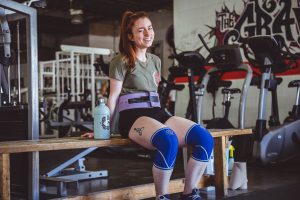 Weightlifting belts were popular in Livermore, CA, before 2000 but have since dropped out of vogue. Some people believe it can inhibit the building of lower back or core strength. It’s not a substitute for using core muscles but a way to increase the stability of your spine if you’re lifting heavy loads. It can help prevent the effect of compression on the spine. Studies show that a belt may allow you to increase muscle activity by as much as 25%. It also increases ab and lower-back muscle use.
Weightlifting belts were popular in Livermore, CA, before 2000 but have since dropped out of vogue. Some people believe it can inhibit the building of lower back or core strength. It’s not a substitute for using core muscles but a way to increase the stability of your spine if you’re lifting heavy loads. It can help prevent the effect of compression on the spine. Studies show that a belt may allow you to increase muscle activity by as much as 25%. It also increases ab and lower-back muscle use.
When you lift, your abs and lower back muscles push on the spine from the outside.
That pressure can cause injury if it isn’t offset by an equal pressure pushing from the inside. That pressure is intra-abdominal pressure. A belt increased that pressure by 40% to push the spine from the inside to offset the outside pressure and stabilize the spine. It can reduce the compression of the discs between the vertebra significantly. The belt doesn’t supply the support, the muscles do. It’s the way the muscles react to the belt that does the job.
Your performance will improve when you use a belt.
Research shows that using a belt can improve muscle growth, power, and strength when doing lower body exercises. One study following lifters with at least five years of doing maximum weight one-repetition lifts compared results from two separate lifts, one with and one without a belt. It showed that a belt allowed the lifters to increase the weight they lift by an average of 10 pounds. Several other research projects showed belts helped increase the activity of the hamstrings and quadriceps. Increased activity of the muscles leads to improved muscle growth. Other studies showed improved lifting speed with a belt.
A belt may improve body mechanics.
The belt makes the lifter more aware of the back position. Feeling the belt against the skin increases the sensation of muscle activation and helps the lifter focus on better lifting posture. You don’t have to wear the belt tightly to get that result but do need it tight for stabilization. It can also improve confidence and a feeling of security, even though there’s no direct effect on muscle activation.
- The belt forms a wall around the lower torso, so it can help prevent hyperextension of the back. It also helps maintain good posture by preventing the lifter from leaning backward, sideways, or twisting.
- A trainer is vital when learning to squeeze ab muscles correctly, but a weightlifting belt can also help. Use the belt in conjunction with work on technical skills, stabilization drills, and core work.
- If you’re wearing the belt tightly, don’t wear your belt for long periods. It may elevate blood pressure when worn longer. Always loosen the belt between sets.
- Only wear belts where back hyperextension may occur or when performing maximal lifts, like deadlifts or squats. For exercises like pull-downs or leg extensions, belts aren’t necessary and do no good. Continuously wearing them may decrease abdominal muscle strength.
For more information, contact us today at LIV Fitness
